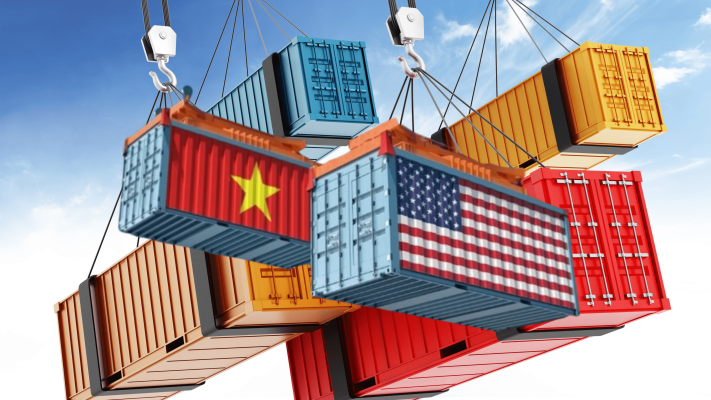U.S. tariffs on Vietnam, Vietnam export industries, impacted sectors Vietnam, trade surplus U.S.-Vietnam, tariff effects 2025
If the U.S. imposes tariffs on Vietnam, key industries such as electronics, machinery, textiles, footwear, and furniture will face significant challenges. These sectors, which dominate Vietnam’s export market, are highly vulnerable to increased trade barriers, according to a recent VIS Rating report.

The U.S. government plans to announce new tariffs on April 2, 2025, as part of its “America First” policy aimed at reducing trade imbalances. Vietnam, a country with a substantial trade surplus with the U.S., is a prime target. This move aligns with efforts to encourage imports of American goods into Vietnam, shrinking the trade gap and shielding Vietnam from harsher measures. The U.S. has already applied higher import tariffs to countries like Canada, China, and Mexico, focusing on industries such as automobiles, aluminum, and steel.
Vietnam’s trade surplus with the U.S. has surged over the past decade, driven by robust export growth. In 2024, the U.S. accounted for nearly 30% of Vietnam’s total export revenue, making it the nation’s top export destination.
Vietnam’s Role in Global Manufacturing
Thanks to foreign investment and shifts in global supply chains, Vietnam has emerged as a manufacturing hub for multinational corporations. However, this success now exposes it to risks from U.S. tariff policies, which remain unpredictable as negotiations continue.
Most Vulnerable Industries in Vietnam
If tariffs increase, VIS Rating predicts that electronics, machinery, textiles, footwear, and furniture will bear the brunt. These industries rely heavily on the U.S. market, with many companies generating a significant portion of their revenue from exports. Here’s why they’re at risk:
- Electronics and Machinery: Multinational firms may adapt by relocating production, but disruptions are still expected.
- Textiles, Footwear, and Furniture: Domestic producers, with fewer options to pivot to new markets, face higher costs and declining orders.
For example:
- Song Hong Garment Company (MSH): 80% of export revenue from the U.S.
- TNG: 46% from the U.S.
- Vietnam National Textile and Garment Group (VGT): 35%.
- Thanh Cong Textile Garment (TCM): 25%.
- Savimex (SAV): 50% of furniture export revenue from the U.S.
How Will Tariffs Impact Vietnam’s Economy?
With exports driving 85% of Vietnam’s GDP in 2024, the stakes are high. Higher U.S. tariffs could:
- Raise prices for American consumers.
- Reduce demand for Vietnamese goods.
- Weaken export revenue and cash flow for businesses.
Since export industries employ 30% of Vietnam’s workforce, a downturn could ripple into domestic consumption. Analysts also warn that prolonged trade restrictions might deter foreign investment and jeopardize Vietnam’s 8% GDP growth target for 2025.
Vietnam’s Response to Tariff Threats
Vietnam and the U.S. have been negotiating to mitigate risks. Recent measures include:
- Lowering import tariffs on U.S. goods.
- Approving deals like SpaceX’s Starlink satellite internet trials in Vietnam.
These steps aim to boost U.S. imports and narrow the trade surplus over time. However, the outcome hinges on ongoing talks, which will shape the scope and duration of any new tariffs.
What’s Next for Vietnam’s Export Sectors?
The impact of U.S. tariffs will vary. Multinational electronics firms might weather the storm by diversifying production, but local textile, footwear, and furniture manufacturers could struggle to find alternative markets. As Vietnam braces for potential changes in 2025, its export-driven economy faces a critical test.
Stay updated on U.S.-Vietnam trade policies and their effects on global supply chains as the April 2, 2025, tariff announcement approaches.




 Tiếng Việt
Tiếng Việt